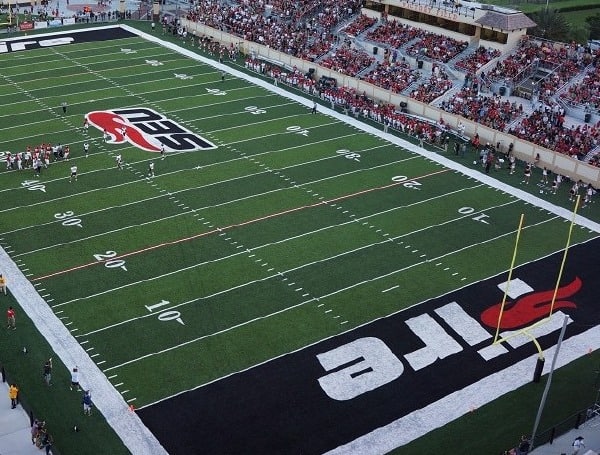LAKELAND, Fla. – The 2021 college football recruiting cycle for the National Association of Intercollegiate Athletics (NAIA) programs is currently underway. It has been just over a year since COVID-19 was declared a national emergency and small university football programs are addressing the recruitment process during this unprecedented time.
The National Collegiate Athletic Association and the NAIA have granted an extra year of eligibility to student-athletes due to complications from the effects of COVID-19 on their 2020-2021 playing year. This move has limited scholarship opportunities around the country for incoming 2021 recruits. The pandemic has also changed the way coaches recruit on the road with some highschools not allowing coaches to come onto their campus. This has led coaching staff and potential recruits to adapt to a completely new recruiting process.
“COVID has affected recruiting on different levels,” said Richard McNutt, defensive back coach and recruiting coordinator at Southeastern University. “A lot of guys have not been able to show themselves off because of seasons being canceled and moved.”
SEU is a small private liberal arts college in Lakeland, Florida that carries an NAIA football program. The school has felt the effects of recruiting during a pandemic like many other campuses of their size.
Over the course of the pandemic, much of the university’s recruiting process was done virtually. In recent months Southeastern has come up with a way to meet recruits and see them workout despite not seeing some of them play in person during the fall.
SEU’s football program has supplemented the lack of in-person recruiting during the season with one-day visits where they put recruits through workouts on the field.
Each recruit and their guests are screened for COVID-19 and then given a campus tour by the campus admissions department. At the end of the tour, they get their height and weight recorded by the football program and proceed to the field for a workout.
“The one-day events allow students and parents to get a lot of information that they would not be able to get over the phone,” said McNutt. “Kids can see what our campus looks like and we can evaluate them further. We can get multiple eyes on a kid and confirm or deny what we saw on film. Plus it allows us to start making connections with them.”
Ave Maria University, a private catholic university in Ave Maria, Florida who also plays in the Mid South Conference along with Southeastern finds themselves dealing with similar recruitment issues.
“It is always good to see a kid in person,” said Keith Gilmore, Ave Maria’s defensive coordinator, “You think a kid is A, B, or C sized and you get there and he is 50 pounds smaller and three inches shorter so it hurts in that respect.”
Ave Maria along with many other universities including Southeastern are looking towards social media platforms to look into the background of potential student-athletes and to be able to see what they look like off the field. Though often used, this is especially beneficial to the recruitment process during a pandemic.
“There are other ways to see and to get to know kids whether it be through Facebook or Twitter,” said Gilmore.
Gilmore does believe that smaller schools may have a chance at recruits that they did not have in the past. With the NCAA granting every athlete another year of eligibility, a lot of universities will have fewer scholarships to give out. This allows smaller schools to have the ability to show recruits and their families that smaller college football has a lot to offer them.
“I think the pool for highschool kids is bigger for us now,” said Gilmore. “There are probably some kids we have a shot at now that we did not have in the past.” McNutt echoed this when talking about the amount of talent still out there ready to be recruited.
“There is a trickle-down effect,” said McNutt. “The bigger recruits that were unable to get a scholarship will now be looking for opportunities at different levels and if you are a good recruiter, you will always go out and look for the guy that can play at a higher level than where you are at.”
McNutt and Gilmore both stated the importance of college athletics not just for the university but for the players. Scholarships historically have allowed students from all over the country to be able to attend schools that their financial means may not have allowed. They want student-athletes to know that they can accomplish the goal of playing the sport they love and getting a degree even at a smaller level.
“I know these kids are going to find the best opportunities they can find and make the best of it,” said McNutt. “We can still provide guidance and coaching and ultimately it is about the kids getting their degree and being successful.”
With several states no longer requiring facemasks and 18.1% of the U.S. population receiving at least one dose of the COVID vaccine (according to the CDC), there is hope that the next recruiting cycle will look much like it did pre-COVID. Gilmore does believe there were some aspects that came from this cycle that might stick in the future.
“I think people are finding that there are ways to recruit without spending as much money,” said Gilmore. “I think the amount of time on the road recruiting will be reduced. You will be able to see you can still get a pretty solid recruiting class without going that route.”
Both coaches emphasized that all levels of college football are affected and dealing with their own issues, not just smaller universities. Programs have had to overcome these challenges. Every university found a way to recruit this cycle. With spring football getting ready to start for many programs the 2021-2022 season is already in-sight. Programs are hopeful that their diligence with recruiting in an unprecedented time will pay off in the win column come fall.
Support journalism by clicking here to our gofundme or sign up for our free newsletter by clicking here.


